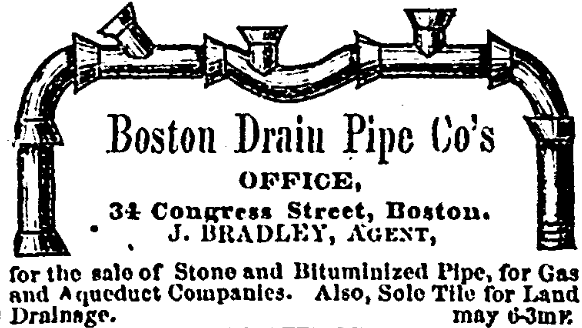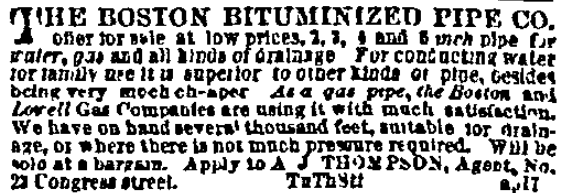


| Introduction | Historical Background | Chronology | Geography | Biography | Technology | Ownership and Financing | General Bibliography |
| Technology | Asphalt Pipe |
A few water works systems used asphalt pipes, with the largest being Niles, Michigan, but they were universally unsuccessful and replaced with other materials. Asphalt was also used as a coating for many types of wood and metal materials.
Pipe made from wood fiber mixed with asphalt was commonly known as Orangeburg pipe. This was widely used for sewer piping until the 1970s, but several web sites refer to "The first known use of fiber pipe was in an experimental water delivery pipe in the Boston area. The pipeline, finished in 1867, measured 1.5 miles in length and was in use through 1927." No evidence of this pipeline have been found, although it could have made by one of the bituminized pipe companies incorporated in Boston in the early 1860s.
The American Bituminized Pipe Company was incorporated on April 20, 1862 and the Boston Bituminized Pipe Company on October 20, 1863. Both were dissolved in the early 1870s and left few traces.
Several other asphalt pipe companies appeared between 1870 and 1900, but apart from the installation in Niles it is not known if any significant quantities were ever installed.
 |
 |
 |
| Massachusetts Ploughman, May 13, 1865, Page 3. | Boston Journal, April 21, 1866, Supplement page 2. | New York Herald, August 28, 1872, Page 7 |
References
1860 "Bituminous
Paper Tubing," Cincinnati Daily Press, April 18, 1860, Page
1.
Am experiment was recently performed in London for trying the strength, by
hydraulic pressure, of a new description of tubing, composed of bituminous
paper. This new contrivance for subterranean tubes was invented in
Paris. The municipal authorities of Paris tried these tubes for the
conveyance of gas, and in recent experiments made in London, a piece of
the tube was produced, which, though stated to have been used under ground
as a gas-pipe for twelve months, bad the appearance of being a new pipe.
The tubes, subjected to a pressure of the hydraulic process, bore a strain
of two hundred and fifty pounds to the square inch without bursting which
is more than they would be required to bear in ordinary use. One of the
tubes, half an inch thick, and with a bore of two inches, was also tested
by weight, and it only gave way to a pressure of five hundred and eighty
pounds, the bearings being three feet apart. It was stated that the
tubes might be submitted to a temperature of 160 degrees of Fahrenheit,
without any deterioration of the material. The cost of the tubing is said
to be less than half that of the ordinary tubing,
1862 An act to incorporate the American Bituminized Pipe Company. April 30, 1862.
1862 "Making Tubes of Paper," Blue Hen's Chicken and Commonwealth (Wilmington, Delaware), May 28, 1862, Page 3.
1862 "Bituminized Water Pipe," Maine Farmer, July 3, 1862, Page 2.
1862 The
Practical Mechanic's Journal of the Great Exhibition
Page 247: There are several examples in the Exhibition of
bituminized paper pipes, which appear likely in many cases to supersede
those of cast iron. They are lighter and cheaper, they are easily laid and
jointed, impart no taste to the water, and will not corrode. They are only
about two-thirds the price of iron; and though there has not yet been time
for sufficient experience, they will probably be durable, and are
certainly capable of bearing great pressure. For the small pipes of many
waterworks, and for all private supplies, they will in all probability be
found very suitable. The chief exhibiters of this kind of pipe are the
Patent Bituminized Pipe Company; M. Jaloureau, Paris; and MM. Schröder
& Schmerbauch. The mode in which these pipes are united is simple and
effective. Two plain ends are brought together, a collar of a few inches
in length is drawn over the joint, having a space of about 3 inch between
the inside of the collar and the outside of the pipe, and this space is
filled with melted bituminous cement, which when cold is as hard and
impervious as the body of the pipe, and makes a perfectly watertight
joint. The ferrules to which the service-pipes are attached are easily and
securely screwed through these joints into the pipe.
1863 Daily
News (London, England), June 22, 1863, Page 1.
Bankruptcy of the Patent Bituminized Water, Gas, and Drainage Pipe Company
(Limited)
1863 Certificate of corporation , Boston Bituminized Pipe Company. October 20, 1863.
1864 Boston Post,
March 15, 1864, Page 2.
The Boston Bituminized Pipe Company are now prepared to take orders for
Pipe, either for Water or Gas, as a substitute for Cast Iron. It is
much cheaper, stronger, and more durable than Iron Pipe. Apply to P.
S. Shelton & Co., No. 4 Central Wharf.
1864 "Bituminous Paper Pipes," The Evening Telegraph (Philadelphia, Pennsylvania), October 22, 1864, Page 2.
1865 "Bituminized Paper Pipes, and Roof Sheeting," Journal of the Franklin Institute, 72:210-212 (March, 1865)
1865 Flag of our Union
(Boston, Massachusetts), September 30, 1865, Page 16.
Water-pipes made of clay and bitumen, strong enough to withstand a
pressure of five hundred pounds to the square inch, are manufactured in
England and France. Compared with iron pipes, the specific gravity
of those of bituminized paper is as one to five, whilst the cost of the
latter is stated to be about one-half that of the former.
1865 New
England Business Directory
Page 825: Boston Bituminized Pipe Company, John L. Webster, capital
$37,000
1866 Alexandria
Gazette, August 8, 1866, Page 3.
Pipes composed of biruminized paper are used to convey gas and water
through the streets of Paris.
1869 An
act to incorporate the Milwaukee asphalt pipe and roofing paper
manufacturing company. February 17, 1869.
Incorporators: Francis Huebschmann, James S. Brown, William Helms,
Alexander Mitchell, Edward Von Wolzogen, and Valentine Kuhlmann.
1872 "Water,
Water-Pipes, and Water-Filters," The New York Times, April
20, 1873, Page 5.
Mentions bituminized paper water pipes.
1873 US Patent 142448, Improvement in the manufacture of pipe, by George L. Eagan of San Francisco, California, September 2, 1873.
1873 US Patent 143,922, Improvement in the Manufacture of Asphalt Pipe, Adolph Müller, of Jersey City, New Jersey, September 20, 1873.
1874 The
civil engineer's pocket-book, Third Edition, by John C.
Trautwine
Page 577: Pipes made of bituminized paper, prepared under great
pressure, have been used for both water and gas. They are much less liable
to break than cast-iron, and do not weigh or cost more than about half as
much. Pipes of 5 ins bore and ½ inch thick, have resisted test strains of
220 lbs per sq iuch; equal to a water head of 507 ft.
1875 "Holyoke.
A New Manufacturing Enterprise," Springfield Republican,
June 16, 1875, Page 6.
The manufacture of water, gas and sewer pipes from felt paper, or burlaps,
and asphaltum, a patent for which was issue in 1873 to G. L. Eagan of San
Francisco, and which has since been bought by New York and Philadelphia
parties. This manufacture was begun at South Holyoke, yesterday
afternoon, by G. M. Fuller or Northampton and S. R. Bell of Hadley.
1875 Springfield
Republican, August 26, 1875, Page 6.
Fuller & Bell now going right away with their asphalt pipe
manufacture, making several hundred feet a day, which is all taken up by
orders from neighboring cities and towns.
1875 Springfield
Republican, November 23, 1875, Page 6.
Fuller & Bell have hard from their asphalt pipe recently laid in
Montreal. It was a four-inch pipe, completely exposed, full of
standing water, with the temperature down to zero, last week, but it
didn't freeze. That city puts in iron pipes down eight feet deep to
keep them from freezing, but the asphalt will be laid only one foot.
1876 Springfield
Republican, February 18, 1876, Page 6.
Holyoke is soon to lose an industry which bids fair to become an extensive
one. The Bridgeport board of trade have tried for some time to
induce Bell & Fuller to move their asphalt pipe manufactory to that
city, which they have at last decided to do. A stock company has
been organized under the name of the Asphalt pipe company, which a capital
stock of $50,000, $10,000 of which is taken by Bridgeport parties, and
these directors: G. M. Fuller of Holyoke, president and general
manager; A. S. Thomas of Brooklyn, secretary; J. E. Fuller of Brooklyn,
treasurer; S. R. Bell of Hadley and H. E. Halloway of Brooklyn. They
will move their works, April 1, and start off with good prospects, having
made a large contract to furnish water and gas pipes to Bridgeport, and a
quantity of gas pipe to Northampton. They are also negotiating with
the authorities of Battle Creek, Mich., about furnishing pipe for that
city. R. S. Potter, agent for the Dominion pipe company of St.
Catherines, P.O., to whom they have sold the right to manufacture their
goods in Canada, has examined and accepted the machinery manufactured for
them, and it will be shipped to Canada, tomorrow.
1876 US Patent 179,183, Improvement in Machines for Making Pipe, by George M. Fuller, of Holyoke, Massachusetts, assignor to the Asphalt Pipe Company, (Limited), or New York, June 26, 1876.
1880 U.S. Census, Owego,
Tioga County, New York, June 1, 1880
George M. Fuller, age 44, President of Asphalt Pipe Co.
1881 Truth (New
York, New York), January 10, 1881, Page 4.
Messrs. Mordecai & Bellamy will sell at the Exchange Salerooms, 111
Broadway, at 12 o'clock, Wednesday, January 12, 1881, through P.F. Meyer,
Auctioneer, all the material, property and assets belonging to the
"Wrought Iron Asphalt Pipe Company."
1881 "Asphalt Pipe," Kansas City Star, October 4, 1881, Page 4.
1884 "Water-Pipe,"
Engineering Record 9:613 (May 29, 1884)
Page 613: There is no such thing as asphalt water-pipe that we know
of.
1886 "Water
Pipes," by A. H. Howland, Read December 4, 1886, Proceedings of
the Engineers' Club of Philadelphia 6(1):55-69. (December,
1886). Howland developed
many water works in the 1880s and 1890s.
Page 68: Composition Pipes. Composition pipes made of various
substances, but principally of asphaltum and canvas, have been used to a
limited extend but found entirely inadequate as to capacity, durability,
and convenience of handling.
1890 US Patent 420,844, Pipe, John P. Culver, of Los Angeles, California, June 10, 1890. Culver was chief engineer of the Jersey City water works in 1871.
1892 Las
Cruces Sun News (Las Cruces, New Mexico), June 3, 1892, Page
4.
B. J. McQuin, representative for Culver's Indestructible Sheet Iron and
Asphalt Water Pipe
1895 "Consolidated
Pipe Company," advertisement, Rural Californian 18(9):416
(September, 1895)
Culver Indestructible steel pressure pipe
1895 "The
Culver Iron and Asphalt Water Pipe," Rural Californian
18(9):461 (September, 1895)
John P. Culver of Los Angeles
1895 US Patent 540,202, Pipe, Henry F. Williams of San Francisco, assignor to the Improved Asphalt Pipe Company, of Bakersfield, California, May 28, 1895.
1895 "Improved Asphalt Pipe," San Francisco Chronicle, September 15, 1895, Page 22.
1899 "Asphalt Paper Pipe," The Los Angeles Times, November 19, 1899, Page 62.
1901 "Bituminized Paper Water Pipes," Municipal Engineering 21:333 (November, 1901)
1902 "Bituminized
Paper Water Pipes," Municipal Engineering 22(6):388 (June,
1902)
Asphalt Paper Pipe Company, of Los Angeles, describes the tubes made by
them of felt (wool fiber) paper of high tensile strength, saturated with a
refined asphaltum compound and rolled on a mandrel under great pressure.
2015 "Hillsboro
Postmaster Convicted of Embezzelement Chooses the Death Penalty," By Mark
Thompson, Guajalotes,
Zopilotes, y Paisanos, Hillsboro HIstorical Society 8(1):3-6
(February, 2015)
Includes details of George M. Fuller's life, including his move to New
Mexico around 1882.
Also see the general bibliography page, which
includes links to several lists of waterworks with information about
pipes.
© 2019 Morris A. Pierce